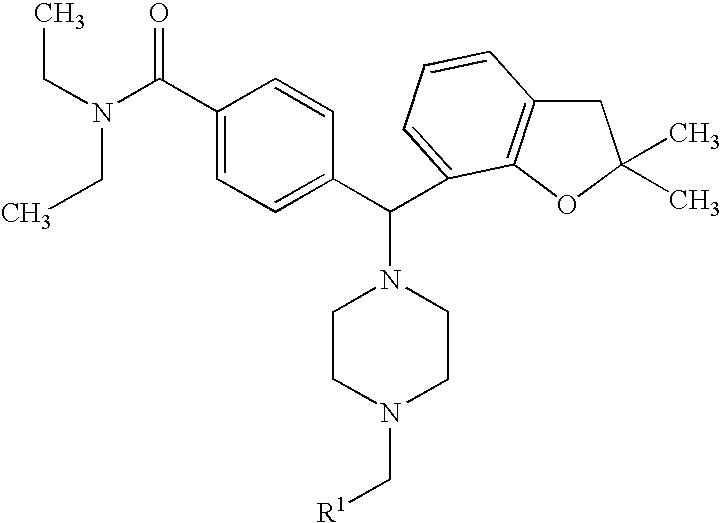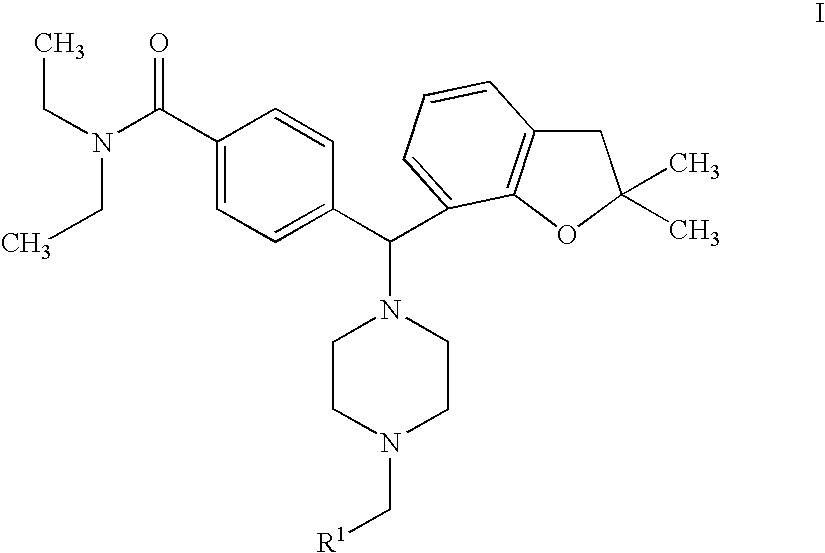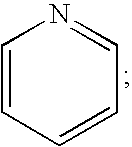Piperazinomethylbenzamides as delta-opioid receptor agonists
a technology of deltaopioid receptor and piperazinomethylbenzamide, which is applied in the direction of drug composition, immunological disorders, organic chemistry, etc., can solve the problems of poor pharmacokinetics, unsuitable systemic administration, and inability to analgesic
- Summary
- Abstract
- Description
- Claims
- Application Information
AI Technical Summary
Benefits of technology
Problems solved by technology
Method used
Image
Examples
example 1
Preparation of 4-[(4-benzyl-1-piperazinyl)(2,2-dimethyl-2,3-dihydro-1-benzofuran-7-yl)methyl]-N,N-diethylbenzamide Dihydrochloride (Compound 6)
(i) Preparation of 2,2-Dimethyl-2,3-dihydro-1-benzofuran-7-yl Trifluoromethanesulfonate (Compound 1)
2,2-dimethyl-2,3-dihydro-1-benzofuran-7-ol (19 g, 0.11 mol) and pyridine (18 mL, 0.23 mol) was dissolved in CH.sub.2 Cl.sub.2 at 0.degree. C. Triflic anhydride (23 mL, 0.14 mol) was added dropwise. After strirring 1 h at 25.degree. C. the mixture was diluted with CH.sub.2 Cl.sub.2 and washed with HCl (aq.), dried (Mg SO.sub.4) and evaporated in vacuo.
Yield 32 g (96%) of compound 1, which did not need purification but was used directly in the following step.
.sup.1 H NMR (CDCl.sub.3) .delta. 1.50 (s, 6H), 3.09 (s, 2H), 6.81 (m, 1H), 7.03 (m, 1H), 7.11 (m, 1H), MS (EI) m / e 296, 163, 135, 107.
(ii) Preparation of Methyl 2,2-dimethyl-2,3-dihydro-1-benzofuran-7-carboxylate (Compound 2)
Compound 1 prepared in the previous step above (32 g, 0.11 mol) was...
example 2
Preparation of 4-{(2,2-dimethyl-2,3-dihydro-1-benzofuran-7-yl)[4-(4-iodobenzyl)-1-piperazinyl]methyl}-N,N-diethylbenzamide Dihydrochloride (Compound 7)
Procedure as for compound 6. Compound 5 (0.12 g, 0.29 mmol) was reacted with 4-iodobenzyl bromide (96 mg, 0.32 mmol) for 48 h to give the title compound 7 (56 mg, 88 .mu.mol).
MS (ES) 638.24 (MH+). IR (NaCl, free amine, v.sub.max) 2969, 2810, 1630, 1451, 1288, 1135, 1007 cm.sup.-1.
.sup.1 H NMR (CDCl.sub.3, free amine) .delta. 1.1, 1.2 (2m, 6H, amide-Me), 1.36, 1.45 (2s, 6H, Me2C), 2.4 (m, 8H, piperazine-H), 2.94 (m, 2H, ArCH2), 3.2, 3.5 (2m, amide-CH2), 3.43 (s, 2H, ArCH2N), 4.62 (s, 1H, Ar2CH), 6.73 (m, 1H, Ar--H), 6.94 (d, J=7.3 Hz, 1H, ArH), 7.05 (d, J=8.0 Hz, 2H, ArH), 7.19 (d, J=6.6 Hz, 1H, ArH), 7.25 (d, J=8.0 Hz, 2H, ArH), 7.48 (d, J=8.0 Hz, 2H, ArH), 7.61 (d, J=8.0 Hz, 2H, ArH). Anal. (C.sub.26 H.sub.37 Cl.sub.2 N.sub.3 O.sub.2) C, H, N.
example 3
Preparation of 4-{(2,2-dimethyl-2,3-dihydro-1-benzofuran-7-yl)[4-(3-pyridinylmethyl)-1-piperazinyl]methyl}-N,N-diethylbenzamide Dihydrochloride (Compound 8)
Compound 5 (0.20 g, 0.47 mmol) was dissolved in MeOH (2 mL) with 3-pyridine carboxaldehyde(90 .mu.L, 0.95 mmol) and HOAc (3 .mu.L, 50 .mu.mol). Sodium cyanoborohydride (60 mg, 0.95 mmol) was added at 0.degree. C. and reaction stirred 48 h at 25.degree. C. Reaction was worked up by concentration in vacuo, extraction (CH.sub.2 Cl.sub.2 / K.sub.2 CO.sub.3 (aq)) and chromatography on silica (0 to 10% MeOH in CH.sub.2 Cl.sub.2) to give the title compound .delta. (82 mg, 0.16 mmol). Dihydrochloride made with HCl (aq) and lyophilization.
MS 513.25 (MH+). IR (NaCl, free amine, v.sub.max) 2970, 2808, 2360, 1631, 1452, 1425, 1290, 1135, 1096, 1009 cm.sup.-1.
.sup.1 H NMR (CDCl.sub.3, free amine) .delta. 1.1, 1.2 (2m, 6H, amide-Me), 1.36, 1.46 (2s, 6H, Me2C), 2.5 (m, 8H, piperazine-H), 2.94 (m, 2H, ArCH2), 3.2, 3.5 (2m, amide-CH2), 3.51 (s, 2H...
PUM
| Property | Measurement | Unit |
|---|---|---|
| pH | aaaaa | aaaaa |
| pH | aaaaa | aaaaa |
| pH | aaaaa | aaaaa |
Abstract
Description
Claims
Application Information
 Login to View More
Login to View More - R&D
- Intellectual Property
- Life Sciences
- Materials
- Tech Scout
- Unparalleled Data Quality
- Higher Quality Content
- 60% Fewer Hallucinations
Browse by: Latest US Patents, China's latest patents, Technical Efficacy Thesaurus, Application Domain, Technology Topic, Popular Technical Reports.
© 2025 PatSnap. All rights reserved.Legal|Privacy policy|Modern Slavery Act Transparency Statement|Sitemap|About US| Contact US: help@patsnap.com



